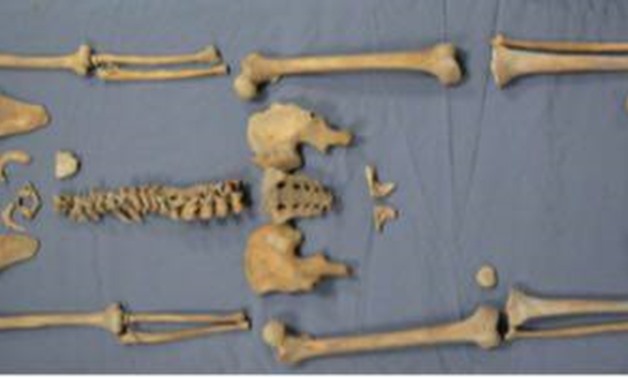
Mostafa Waziri declared that researchers determined the gender and age of the skeletons found inside the Alexandria sarcophagus - Ministry of Antiquities Official Facebook Page.
CAIRO – 19 August 2018: Head of the Supreme Council of Antiquities Mostafa Waziri declared that the preliminary studies determined the gender and age of the skeletons found inside the Alexandria sarcophagus through the anthropological examination of the anatomy of the skulls, pelvis and longitudinal bones.

The preliminary studies were carried out by the research team, headed by the director of the skeleton remains studies department at the Ministry of Antiquities, Zeinab Hashish.

Waziry added that the team also found gold sheets within the bones of the skeletons which are now subject to study.

Head of the Central Department of Antiquities of Lower Egypt Nadia Kheider recounted that the first skeleton belongs to a woman aged 20 - 25 years old, with a height of around 160 - 164 cm.
The second skeleton belongs to a man aged 35 - 39 years old, with a height ranging between 160 - 165.5 cm, while the third skeleton is for a man aged 40 - 44 years old and with a height ranging between 179 - 184.5 cm.
She pointed out that studies on the right bone located on the back area of the skull shows a rounded cavity of 17 cm wide which reveals that the owner of this skull survived a long period with this cavity. This means that the cavity is a result of a surgery.
“This surgery is the oldest surgical intervention known in the pre-historical era; it was rare in Egypt,” Hashish stated, adding that few skulls with this surgery were found in Qasr El-Eini Hospital museum and in the Maya and Merit’s tombs in Saqqara Necropolis.
Head of the Ancient Egyptian Antiquities Sector Ayman Ashmawy said that the researchers cleaned all the remains found inside the sarcophagus and archaeologically documented all the bones and skulls as well as the gold sheets.
He pointed out that the strange color of the water found inside the sarcophagus came from mixing the sewage water with the remains of the skeletons’ wrappings which were decomposed by the sewage water.
Ashmawy said that several analyses are carried out on the water to uncover more about its components. Waziri asserted that more researches, DNA tests and Ct-Scans are carried out on the bones of the skeletons to know more about them and whether they have any familial relations.
On July 1, Egypt unearthed a 2,000-year-old sarcophagus in Alexandria, revealing that it is made of black granite of about 265 meters in length and 185 centimetres in height. The 30-ton tomb was found at a depth of 5 meters beneath the surface of the land.
On July 19, Egypt opened the mysterious sarcophagus, amid rumours of a "possible curse" that could be cast on the world once the sarcophagus is opened. Three decomposed mummies were found in the sarcophagus, declared Secretary-General of the Supreme Council of Antiquities, Waziri.
Waziri stressed that none of the three mummies belong to a Ptolemaic or Roman royal family and the coffin does not have inscriptions or a cartouche bearing their names.
He further pointed out that no evidence such as silver or gold metallic masks, small statues, amulets or inscriptions were found to prove that the mummies belong to a royal family.
In this regard, he denied the rumours spread by some international newspapers that opening the sarcophagus would unleash the curse that would bring disaster to the world.
Since its discovery, the mysterious tomb has internationally grasped attention, and several international websites warned of its opening as it would be “a risky business or so history tells us” for the possibility of unleashing the curse that would bring disaster to the world, as remarked by the British news website The Sun.




Comments
Leave a Comment